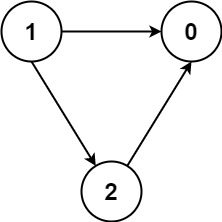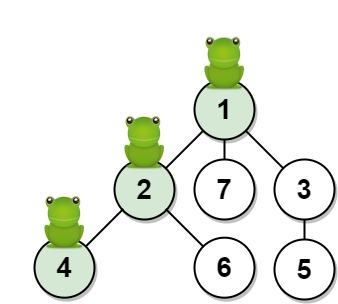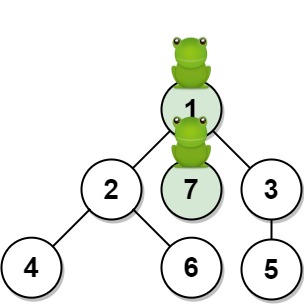目录
OpenJ_Bailian - 4084 拓扑排序(BFS)
一,有向图拓扑排序
有向无环图的拓扑排序是指给所有节点排序,使得所有的有向边都是从序号小的节点指向序号大的。
深度优先搜索和广度优先搜索都可以用于产生拓扑排序。
PS:不需要指定起点,算法自动寻找入度为0的点作为起点。起点可能不止1个,即使起点唯一,拓扑排序的结果也可能有很多种。
//有向图拓扑排序
class DirectedTopoSort :public KosarajuStrongConnect
{
public:
//有向无环图拓扑排序,输入n=3,g.edges={{0,1}{0,2}{1,2}}, 输出{0,1,2},有环则输出为空
static vector<int> topoSortNoCircle(int n, DirectedGraphData<int>& g)
{
auto& v = g.edges;
priority_queue<int, vector<int>, greater<int>> q;
map<int, int>m;
for (auto &vi : v)m[vi.b]++;
for (int i = 0; i < n; i++)if (m[i] == 0)q.push(i);
vector<int>ans;
auto &mv = g.adjaList;
while (!q.empty()) {
int k = q.top();
q.pop();
ans.push_back(k);
for (auto i : mv[k]) {
m[i]--;
if (m[i] == 0)q.push(i);
}
}
return ans.size() == n ? ans : vector<int>{};
}
//有向图拓扑排序
static vector<vector<int>> topoSort(DirectedGraphData<int>& g)
{
vector<vector<int>> con = connectComponent(g.adjaList);
map<int, vector<int>> pointGraph = getPointGraph(con, g.adjaList);
DirectedGraphData<int>ga(pointGraph);
vector<int> vp = topoSortNoCircle(con.size(), ga);
vector<vector<int>>ans;
for (auto id : vp)ans.push_back(con[id]);
return ans;
}
};力扣 210. 课程表 II(DFS)
现在你总共有 n 门课需要选,记为 0 到 n-1。
在选修某些课程之前需要一些先修课程。 例如,想要学习课程 0 ,你需要先完成课程 1 ,我们用一个匹配来表示他们: [0,1]
给定课程总量以及它们的先决条件,返回你为了学完所有课程所安排的学习顺序。
可能会有多个正确的顺序,你只要返回一种就可以了。如果不可能完成所有课程,返回一个空数组。
示例 1:
输入: 2, [[1,0]]
输出: [0,1]
解释: 总共有 2 门课程。要学习课程 1,你需要先完成课程 0。因此,正确的课程顺序为 [0,1] 。
示例 2:
输入: 4, [[1,0],[2,0],[3,1],[3,2]]
输出: [0,1,2,3] or [0,2,1,3]
解释: 总共有 4 门课程。要学习课程 3,你应该先完成课程 1 和课程 2。并且课程 1 和课程 2 都应该排在课程 0 之后。
因此,一个正确的课程顺序是 [0,1,2,3] 。另一个正确的排序是 [0,2,1,3] 。
说明:
输入的先决条件是由边缘列表表示的图形,而不是邻接矩阵。详情请参见图的表示法。
你可以假定输入的先决条件中没有重复的边。
提示:
1 <= numCourses <= 2000
0 <= prerequisites.length <= numCourses * (numCourses - 1)
prerequisites[i].length == 2
0 <= ai, bi < numCourses
ai != bi
所有[ai, bi] 互不相同
class Solution {
public:
void findOrder(vector<vector<int>>& diag, int loc, vector<int>& ans)
{
if (outNum[loc] || flag[loc])return;
ans.push_back(loc);
flag[loc]++;
for (int i = 0; i < diag[loc].size(); i++)
{
outNum[diag[loc][i]]--;
findOrder(diag, diag[loc][i], ans);
}
}
vector<int> findOrder(int numCourses, vector<vector<int>>& prerequisites) {
vector<int>tmp;
map<int, vector<int>>m;
vector<vector<int>>diag;
for (int i = 0; i < numCourses; i++)
{
diag.insert(diag.end(), tmp);
visitt[i] = 0, outNum[i] = 0, flag[i] = 0;
}
for (int i = 0; i < prerequisites.size(); i++)
{
diag[prerequisites[i][1]].push_back(prerequisites[i][0]);
m[prerequisites[i][1]].push_back(prerequisites[i][0]);
outNum[prerequisites[i][0]]++;
}
if (HasDirectedCircle(numCourses, m))return tmp;
vector<int>ans;
flag.clear();
for (int i = 0; i < numCourses; i++)
{
findOrder(diag, i, ans);
}
return ans;
}
private:
map<int, int>visitt;//单次访问标记
map<int, int>flag;//所有访问标记
map<int, int>inNum;//入度
map<int, int>outNum;//出度
};OpenJ_Bailian - 4084 拓扑排序(BFS)
给出一个图的结构,输出其拓扑排序序列,要求在同等条件下,编号小的顶点在前。
Input
若干行整数,第一行有2个数,分别为顶点数v和弧数a,接下来有a行,每一行有2个数,分别是该条弧所关联的两个顶点编号。
v<=100, a<=500
Output
若干个空格隔开的顶点构成的序列(用小写字母)。
Sample
| Inputcopy | Outputcopy |
|---|---|
6 8 1 2 1 3 1 4 3 2 3 5 4 5 6 4 6 5 | v1 v3 v2 v6 v4 v5 |
注意这题输出的顺序,要输出所有拓扑排序的最小字典序的那个。
#include <iostream>
#include <string>
#include <vector>
#include <string.h>
#include <map>
#include <queue>
using namespace std;
//输入有向边集{{1,2}{1,3}{2,3}},输出邻接表{1:{2,3},2:{3}}
map<int, vector<int>> edgeToAdjaList(const vector<vector<int>>& v)
{
map<int, vector<int>> ans;
for (auto &vi : v) {
ans[vi[0]].push_back(vi[1]);
}
return ans;
}
//拓扑排序 BFS版
//输入n=3,v={{0,1}{0,2}{1,2}}, 输出{0,1,2},有环则输出为空
vector<int> TopoSort(int n, const vector<vector<int>>&v)
{
priority_queue<int, vector<int>, greater<int>> q;
map<int, int>m;
for (auto vi : v)m[vi[1]]++;
for (int i = 0; i < n; i++)if(m[i]==0)q.push(i);
vector<int>ans;
auto mv = edgeToAdjaList(v);
while (!q.empty()) {
int k = q.top();
q.pop();
ans.push_back(k);
for (auto i : mv[k]) {
m[i]--;
if (m[i] == 0)q.push(i);
}
}
return ans.size() == n ? ans : vector<int>{};
}
int main()
{
//freopen("D:/in.txt", "r",stdin);
int v, a, x, y;
cin >> v >> a;
vector<vector<int>> p;
while (a--) {
cin >> x >> y;
p.push_back(vector<int>{x-1, y-1});
}
auto ans = TopoSort(v, p);
for (int i = 0; i < ans.size(); i++)cout << "v" << ans[i]+1 << " ";
cout << endl;
return 0;
}力扣 1462. 课程表 IV
你总共需要上 numCourses 门课,课程编号依次为 0 到 numCourses-1 。你会得到一个数组 prerequisite ,其中 prerequisites[i] = [ai, bi] 表示如果你想选 bi 课程,你 必须 先选 ai 课程。
- 有的课会有直接的先修课程,比如如果想上课程
1,你必须先上课程0,那么会以[0,1]数对的形式给出先修课程数对。
先决条件也可以是 间接 的。如果课程 a 是课程 b 的先决条件,课程 b 是课程 c 的先决条件,那么课程 a 就是课程 c 的先决条件。
你也得到一个数组 queries ,其中 queries[j] = [uj, vj]。对于第 j 个查询,您应该回答课程 uj 是否是课程 vj 的先决条件。
返回一个布尔数组 answer ,其中 answer[j] 是第 j 个查询的答案。
示例 1:

输入:numCourses = 2, prerequisites = [[1,0]], queries = [[0,1],[1,0]] 输出:[false,true] 解释:课程 0 不是课程 1 的先修课程,但课程 1 是课程 0 的先修课程。
示例 2:
输入:numCourses = 2, prerequisites = [], queries = [[1,0],[0,1]] 输出:[false,false] 解释:没有先修课程对,所以每门课程之间是独立的。
示例 3:

输入:numCourses = 3, prerequisites = [[1,2],[1,0],[2,0]], queries = [[1,0],[1,2]] 输出:[true,true]
提示:
2 <= numCourses <= 1000 <= prerequisites.length <= (numCourses * (numCourses - 1) / 2)prerequisites[i].length == 20 <= ai, bi <= n - 1ai != bi- 每一对
[ai, bi]都 不同 - 先修课程图中没有环。
1 <= queries.length <= 1040 <= ui, vi <= n - 1ui != vi
思路一:暴力bfs
class Solution {
public:
vector<bool> checkIfPrerequisite(int numCourses, vector<vector<int>>& prerequisites, vector<vector<int>>& queries) {
vector<bool>ans;
map<int, vector<int>>m;
for (auto p : prerequisites)m[p[0]].push_back(p[1]);
for (auto qi : queries)ans.push_back(checkIfPrerequisite(numCourses, m, qi[0], qi[1]));
return ans;
}
bool checkIfPrerequisite(int n, map<int, vector<int>>p, int a,int b) {
queue<int>q;
q.push(a);
map<int, int>m;
while (!q.empty()) {
int t = q.front();
if (t == b)return true;
q.pop();
for (auto x : p[t])if (m[x] == 0) {
m[x] = 1;
q.push(x);
}
}
return false;
}
};超时,很正常,有太多重复运算。
思路二:预处理,然后每次查询是O(1)的时间
预处理的方法是从所有入度为0的点开始dfs
class Solution {
public:
vector<bool> checkIfPrerequisite(int n, vector<vector<int>>& prerequisites, vector<vector<int>>& queries) {
map<int, vector<int>>m;
map<int, int>isNotRoot;
for (auto p : prerequisites)m[p[0]].push_back(p[1]), isNotRoot[p[1]] = 1;
allPair.clear();
for (int i = 0; i < n; i++)if (!isNotRoot[i]) {
vector<int>v;
dfs(i,m,v);
}
vector<bool>ans;
for (auto q : queries)ans.push_back(allPair[q[0]][q[1]]);
return ans;
}
void dfs(int r, map<int, vector<int>>&m,vector<int>&v) {
for (auto x : v)allPair[x][r] = 1;
v.push_back(r);
for (auto x : m[r])dfs(x, m, v);
v.erase(v.end() - 1);
}
map<int, map<int, int>>allPair;
};超时,很正常,有太多重复运算。
思路三:预处理,然后每次查询是O(1)的时间
预处理的方法是拓扑排序,然后按照这个顺序遍历即可。
class Solution {
public:
vector<bool> checkIfPrerequisite(int n, vector<vector<int>>& prerequisites, vector<vector<int>>& queries) {
map<int, vector<int>>adjaList;
map<int, vector<int>>fa;
for (auto p : prerequisites)adjaList[p[0]].push_back(p[1]), fa[p[1]].push_back(p[0]);
DirectedGraphData<int>g(adjaList);
vector<int> tp = DirectedTopoSort::topoSortNoCircle(n, g);
map<int, map<int,int>>fas;
for (auto x : tp) {
for (auto f : fa[x]) {
fas[x][f] = 1;
for (auto par : fas[f])fas[x][par.first] = 1;
}
}
vector<bool>ans;
for (auto q : queries)ans.push_back(fas[q[1]][q[0]]);
return ans;
}
};LCR 114. 火星词典
现有一种使用英语字母的外星文语言,这门语言的字母顺序与英语顺序不同。
给定一个字符串列表 words ,作为这门语言的词典,words 中的字符串已经 按这门新语言的字母顺序进行了排序 。
请你根据该词典还原出此语言中已知的字母顺序,并 按字母递增顺序 排列。若不存在合法字母顺序,返回 "" 。若存在多种可能的合法字母顺序,返回其中 任意一种 顺序即可。
字符串 s 字典顺序小于 字符串 t 有两种情况:
- 在第一个不同字母处,如果
s中的字母在这门外星语言的字母顺序中位于t中字母之前,那么s的字典顺序小于t。 - 如果前面
min(s.length, t.length)字母都相同,那么s.length < t.length时,s的字典顺序也小于t。
示例 1:
输入:words = ["wrt","wrf","er","ett","rftt"] 输出:"wertf"
示例 2:
输入:words = ["z","x"] 输出:"zx"
示例 3:
输入:words = ["z","x","z"]
输出:""
解释:不存在合法字母顺序,因此返回 "" 。
提示:
1 <= words.length <= 1001 <= words[i].length <= 100words[i]仅由小写英文字母组成
class Solution {
public:
string alienOrder(vector<string>& words) {
map<char,int>m;
map<int,char>m2;
for(auto &s:words){
for(auto c:s)if(m.find(c)==m.end())m[c]=m.size(),m2[m[c]]=c;
}
map<int, vector<int>> adjaList;
for(int i=1;i<words.size();i++){
auto v=cmp(words[i-1],words[i]);
if(v.empty()){
if(words[i-1].length()>words[i].length())return "";
continue;
}
adjaList[m[v[0]]].push_back(m[v[1]]);
}
DirectedGraphData<int>g(adjaList);
auto v=DirectedTopoSort::topoSortNoCircle(m.size(),g);
string s="";
for(auto vi:v)s+=m2[vi];
return s;
}
vector<char>cmp(string&s1,string &s2){
for(int i=0;i<s1.length()&&i<s2.length();i++){
if(s1[i]!=s2[i])return vector<char>{s1[i],s2[i]};
}
return vector<char>{};
}
};二,无向图拓扑排序
无向无环图拓扑排序是指定节点作为根,把图变成多叉树(一个节点的不同子节点之间无法区分顺序)
//无向拓扑排序,输入无向无环图{{1,2}{1,3}{4,3}}的邻接表和指定根1,输出父节点表{4:3, 3:1, 2:1}
static map<int, int> undirectedEdgeToFatherList(map<int, vector<int>>& m, int root)
{
map<int, int>visit;
map<int, int>fa;
queue<int>q;
q.push(root);
visit[root] = 1;
while (!q.empty()) {
int id = q.front();
q.pop();
for (auto c : m[id]) {
if (visit[c] == 0)q.push(c), fa[c] = id;
visit[c] = 1;
}
}
return fa;
}力扣 1377. T 秒后青蛙的位置
给你一棵由 n 个顶点组成的无向树,顶点编号从 1 到 n。青蛙从 顶点 1 开始起跳。规则如下:
- 在一秒内,青蛙从它所在的当前顶点跳到另一个 未访问 过的顶点(如果它们直接相连)。
- 青蛙无法跳回已经访问过的顶点。
- 如果青蛙可以跳到多个不同顶点,那么它跳到其中任意一个顶点上的机率都相同。
- 如果青蛙不能跳到任何未访问过的顶点上,那么它每次跳跃都会停留在原地。
无向树的边用数组 edges 描述,其中 edges[i] = [ai, bi] 意味着存在一条直接连通 ai 和 bi 两个顶点的边。
返回青蛙在 t 秒后位于目标顶点 target 上的概率。与实际答案相差不超过 10-5 的结果将被视为正确答案。
示例 1:

输入:n = 7, edges = [[1,2],[1,3],[1,7],[2,4],[2,6],[3,5]], t = 2, target = 4 输出:0.16666666666666666 解释:上图显示了青蛙的跳跃路径。青蛙从顶点 1 起跳,第 1 秒 有 1/3 的概率跳到顶点 2 ,然后第 2 秒 有 1/2 的概率跳到顶点 4,因此青蛙在 2 秒后位于顶点 4 的概率是 1/3 * 1/2 = 1/6 = 0.16666666666666666 。
示例 2:

输入:n = 7, edges = [[1,2],[1,3],[1,7],[2,4],[2,6],[3,5]], t = 1, target = 7 输出:0.3333333333333333 解释:上图显示了青蛙的跳跃路径。青蛙从顶点 1 起跳,有 1/3 = 0.3333333333333333 的概率能够 1 秒 后跳到顶点 7 。
提示:
1 <= n <= 100edges.length == n - 1edges[i].length == 21 <= ai, bi <= n1 <= t <= 501 <= target <= n
class Solution {
public:
double frogPosition(int n, vector<vector<int>>& edges, int t, int target) {
map<int, vector<int>>m;
for (auto v : edges) {
m[v[0]].push_back(v[1]);
m[v[1]].push_back(v[0]);
}
map<int, int>fa = UndirectedEdgeToFatherList(m, 1);
m.clear();
for (auto p : fa) {
m[p.second].push_back(p.first);
}
stack<int>s;
s.push(target);
auto x = target;
while (x != 1) {
x = fa[x];
s.push(x);
}
if (t < s.size() - 1)return 0;
if (t > s.size() - 1 && !m[target].empty())return 0;
double ans = 1;
while (!s.empty()) {
x = s.top();
if (x == target)return ans;
s.pop();
ans /= m[x].size();
}
return 0;
}
};三,有向图的唯一拓扑排序
给定有向图,存在唯一的拓扑排序等价于,存在n-1条边把所有的n个节点连起来构成一条简单路径,且其他的边也满足对应的方向。
力扣 LCR 115. 序列重建
给定一个长度为 n 的整数数组 nums ,其中 nums 是范围为 [1,n] 的整数的排列。还提供了一个 2D 整数数组 sequences ,其中 sequences[i] 是 nums 的子序列。
检查 nums 是否是唯一的最短 超序列 。最短 超序列 是 长度最短 的序列,并且所有序列 sequences[i] 都是它的子序列。对于给定的数组 sequences ,可能存在多个有效的 超序列 。
- 例如,对于
sequences = [[1,2],[1,3]],有两个最短的 超序列 ,[1,2,3]和[1,3,2]。 - 而对于
sequences = [[1,2],[1,3],[1,2,3]],唯一可能的最短 超序列 是[1,2,3]。[1,2,3,4]是可能的超序列,但不是最短的。
如果 nums 是序列的唯一最短 超序列 ,则返回 true ,否则返回 false 。
子序列 是一个可以通过从另一个序列中删除一些元素或不删除任何元素,而不改变其余元素的顺序的序列。
示例 1:
输入:nums = [1,2,3], sequences = [[1,2],[1,3]] 输出:false 解释:有两种可能的超序列:[1,2,3]和[1,3,2]。 序列 [1,2] 是[1,2,3]和[1,3,2]的子序列。 序列 [1,3] 是[1,2,3]和[1,3,2]的子序列。 因为 nums 不是唯一最短的超序列,所以返回false。
示例 2:
输入:nums = [1,2,3], sequences = [[1,2]] 输出:false 解释:最短可能的超序列为 [1,2]。 序列 [1,2] 是它的子序列:[1,2]。 因为 nums 不是最短的超序列,所以返回false。
示例 3:
输入:nums = [1,2,3], sequences = [[1,2],[1,3],[2,3]] 输出:true 解释:最短可能的超序列为[1,2,3]。 序列 [1,2] 是它的一个子序列:[1,2,3]。 序列 [1,3] 是它的一个子序列:[1,2,3]。 序列 [2,3] 是它的一个子序列:[1,2,3]。 因为 nums 是唯一最短的超序列,所以返回true。
提示:
n == nums.length1 <= n <= 104nums是[1, n]范围内所有整数的排列1 <= sequences.length <= 1041 <= sequences[i].length <= 1041 <= sum(sequences[i].length) <= 1051 <= sequences[i][j] <= nsequences的所有数组都是 唯一 的sequences[i]是nums的一个子序列
use std::collections::HashMap;
impl Solution {
pub fn sequence_reconstruction(nums: Vec<i32>, sequences: Vec<Vec<i32>>) -> bool {
let mut m = HashMap::new();
for v in sequences{
for i in 1..v.len(){
if m.get_mut(&(v[i-1],v[i])).is_none(){
m.insert((v[i-1],v[i]),1);
}
}
}
for i in 1..nums.len(){
if m.get_mut(&(nums[i-1],nums[i])).is_none(){
return false;
}
}
return true;
}
} 有向图拓扑排序与课程表问题解析
有向图拓扑排序与课程表问题解析




















 1522
1522

 被折叠的 条评论
为什么被折叠?
被折叠的 条评论
为什么被折叠?








